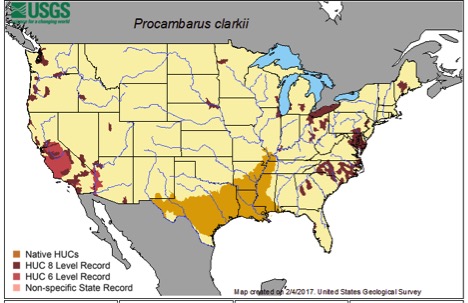National Invasive Species Awareness Week: Red swamp crayfish
This invasive can be a host for parasites and diseases and can carry crayfish fungus plague.

National Invasive Species Week 2017 is Feb. 27 to March 3. Invasive species are plants, animals, and National Invasive Species Week 2017 is Feb. 27 to March 3. Invasive species are plants, animals, and other organisms that are not traditionally found in a given location (in this case the Great Lakes) AND are having a negative impact of some kind, whether ecological, economic, social, and/or a public health threat.
To help bring awareness to these threats, Michigan State University Extension and Michigan Sea Grant are featuring articles on invasive species that have invaded or have the potential to invade Michigan’s environment. This article features the invasive red swamp crayfish.
Species Name: Red Swamp Crayfish (Procambarus clarkii)
Description: According to the Midwest Invasive Species Information Network (MISIN) this invasive crustacean can be up to 5 inches long including claws. They have a dark red body, claws with spiky, bright red bumps and a black wedge-shaped stripe on their underside.
Similar species: The red swamp crayfish is similar to two Michigan native species; White River crayfish and the devil crawfish. The devil crawfish is more tan in color, while the white river crayfish can be tan to red. However, neither native species has the spiky red bumps found on the red swamp crayfish. However, juvenile red swamp crayfish are not red so they are difficult to distinguish from native species. Michigan Sea Grant has published a new "Crayfishes of Michigan" poster which can help identify Michigan's native crayfishes and the two invasives found in the state.
Origin: The red swamp crayfish is native to the Mississippi River drainage and the Gulf Coast.
How it came to the Great Lakes: Red swamp crayfish probably came to the Great Lakes by anglers who purchased live crayfish intended for food and used it as bait or through the aquaculture industry. The Lake Erie introduction may have been intentionally released in an effort to establish populations that could then be harvested for consumption.
How long it has been here: They’ve been found in the Great Lakes as early as 1967 in the Sandusky Bay area of Lake Erie. Although no live red swamp crayfish have been found in Michigan, carcasses were found in 2015 at a popular fishing site on Lake Macatawa.
Extent of range: In addition to its native range in the southern U.S., invasive populations of red swamp crayfish are now found scattered across over two dozen states.
Why it is a problem: According to MISIN, red swamp crayfish can be a host for parasites and diseases and can carry crayfish fungus plague. Once they become established, they can negatively impact an ecosystem due to its diverse diet, including plants, insects, snails, fish and amphibians. It also aggressively competes for food and habitat with native crayfish and other species.
How it is spread: Red swamp crayfish can be spread through a number of different ways including released fishing bait, transported in recreational watercraft, and classroom releases.
A cool/unusual fact: Red swamp crayfish are so hardy that they can survive in some wastewater treatment facilities after being flushed down the toilet.
Management actions/options: Options for managing red swamp crayfish invasions include the elimination or reduction of populations by employing physical, chemical or biological methods and the use of legislation to prohibit the transport and release of specimens. In 2013 Michigan began prohibiting the sale of live red swamp crayfish for bait but they were still allowed for food. In 2014 Michigan law changed to prohibit the movement of all live red swamp crayfish regardless of intended purpose.
What you can do to help prevent the spread: You can prevent the spread of red swamp crayfish by 1) helping to educate others about identifying and preventing their spread, 2) practicing the Clean, Drain and Dry method for watercraft prior to moving them between lakes. (See video) and 3) disposing of unwanted fishing bait and aquarium animals in the trash.
Additional resources
Michigan Sea Grant Red Swamp Crayfish Article
MDNR Michigan Invasive Species: Red Swamp Crayfish Fact Sheet
Midwest Invasive Species Information Network Red Swamp Crayfish Fact Sheet
USGS Red Swamp Crayfish Fact Sheet
Great Lakes Aquatic Nonindigenous Species Information System
Michigan Department of Natural Resources



 Print
Print Email
Email



